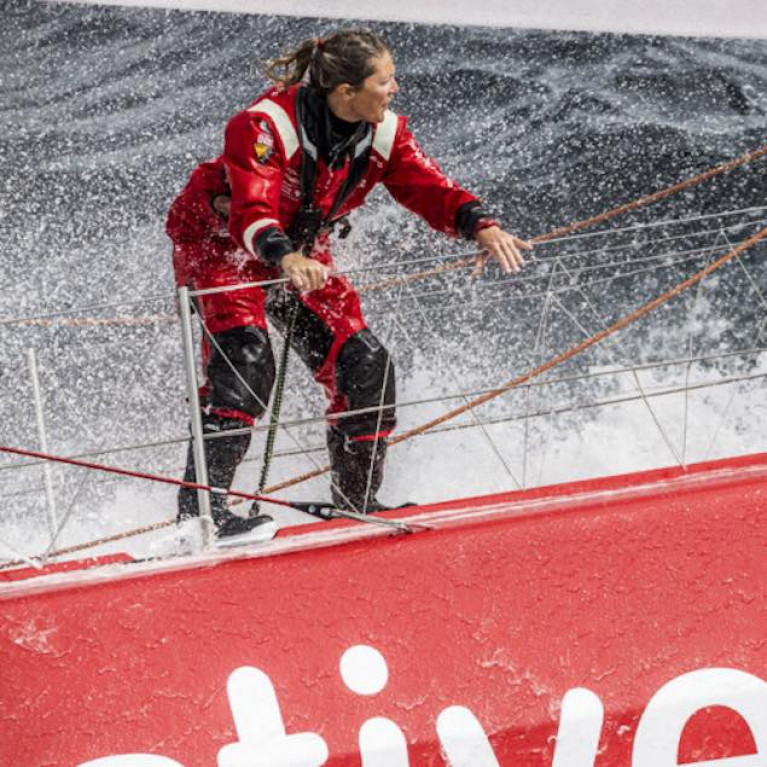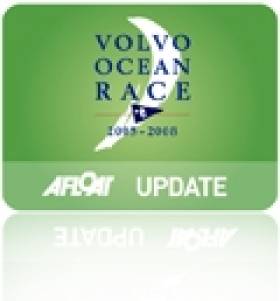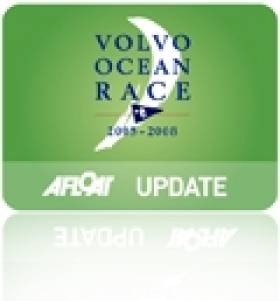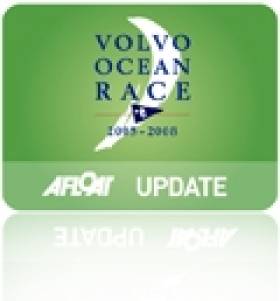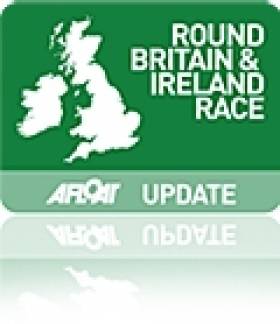Displaying items by tag: Sam Davies
Big Hearted Sam Davies Leaves Her Mark off Les Sables d'Olonne
British solo sailor Sam Davies who retired from the Vendee Globe Race but continued round the world to complete the course will enter the channel back into Les Sables d'Olonne very early this afternoon, around 1215hrs UTC (1315hrs local time) and is expected to get a warm welcome for her remarkable solo round the world achievement which she completed last night. As she waited for daylight and today's tide to fully enjoy the moment Sam Davies had not been idle. In an initiative which is typical of the English skipper, she spent last night scribing a giant heart with the wake of her Initiatives Coeur on the waters off Les Sables d'Olonne.
After being forced to abandon her race on 5th December because of damage caused by a violent collision with a submerged object, Sam restarted out of Cape Town ten days later after repairing her boat and last night completed her solo passage back to Les Sables d'Olonne.
British Solo Sailor Sam Davies Retires From Vendee Globe But Wants to Complete The Route 'Hors Course'
Following a violent collision last Wednesday evening, British Vendee Globe skipper Sam Davies (Initiatives-Cœur) sustained significant damage to the framework supporting the keel of her IMOCA. In consultation with her team, she made the decision to stop in Cape Town (South Africa). This morning as she arrived in Cape Town she confirmed by video at 0900hrs UTC that she is officially retiring from the race. But she says she is determined to return - after making repairs with her team and experts - to complete the race course as 'hors course', unclassified on the solo race which forbids any kind of outside assistance.
Sam Davies & Team SCA Seize Volvo Ocean Race Leg 8 Win
#vor – Skipper Sam Davies (GBR) and her Team SCA crew struck a resounding blow for women's offshore sailing in the early hours of Thursday morning when they gloriously clinched Leg 8 of the Volvo Ocean Race.
The comfortable victory was the first leg win in offshore sailing's toughest challenge since Tracy Edwards' Maiden clinched two stage wins in Class D of the 1989-90 race, won overall by Sir Peter Blake's famous Steinlager2.
At least as satisfying for the first all-women's crew to enter the race in 12 years will be the opportunity to silence critics who suggested that they were looking outclassed in the current 12th edition by their experienced male rivals.
True, the Swedish entry had yet to win a podium place until now, but the crew has clearly improved leg after leg and many observers felt that a breakthrough performance was just around the corner.
The win was certainly no fluke in an upwind leg that tested seamanship to the full with an often heinous sea state and strong winds virtually throughout.
They grabbed the 647-nautical mile leg from Lisbon by the scruff of the neck on Monday, and strengthened that grip on Tuesday after taking an offshore course while most of their rivals hugged the Spanish and French coast approaching the Bay of Biscay.
It took them three days 13 hours 11 minutes and 11 seconds to grab their share of Race history.
"Thanks to everybody for all your support. It's not really sunk in yet," said a jubilant Davies. "It probably won't hit us until we hit the dock and we see there aren't any other boats there.
"It's a reward for all the hard work we have done. It's a great confidence booster. It's going to be huge for us. We've had a mountain to climb to get here."
Behind them, another fairy-tale was unfolding as Team Vestas Wind (Chris Nicholson/AUS) closed to a remarkable second-placed finish in their return to the race after six months out following a collision with an Indian Ocean reef on November 29 during Leg 2.
Nicholson had every reason for the huge smile on his face as he approached the port of Lorient following a near perfect race from Lisbon starting on Sunday.
He had simply hoped that his boat could negotiate the leg without mishap and be competitive – a high podium finish is almost beyond his wildest dreams.
"It's a very special moment," said the team's Onboard Reporter, Brian Carlin (IRL), simply.
Astern of the leading pair, third-placed Abu Dhabi Ocean Racing (Ian Walker/GBR) were nearing an ever bigger prize than the handsome silver leg trophy claimed by Team SCA.
They needed simply to finish ahead of their nearest overall pursuers in the standings,Team Brunel (Bouwe Bekking/NED) and Dongfeng Race Team (Charles Caudrelier/FRA), with a boat in between, to be all but be sure of winning the 12th edition of the Volvo Ocean Race.
As Team SCA passed the finish at 0211 UTC/0411 local time on Thursday, that prospect looked very much on with MAPFRE (Xabi Fernández/ESP) in fourth, Team Brunel fifth, and Team Alvimedica (Charlie Enright/USA) keeping Dongfeng Race Team at bay in the fight for sixth.
The boats will have a short maintenance period before Sunday's SCA In-Port Race here in Lorient, before the fleet set sail for Gothenburg via a much-awaited pit-stop in The Hague, on Tuesday, June 16.
It promises to be a period of considerable celebration for at least three crews of very, very happy sailors.
Team SCA PR below:
A sweet victory for Team SCA in Lorient
The culmination of over two years of hard work came together today for Team SCA, as they crossed the finish line after 3 days 13 hours 11 minutes and 11 seconds to take their first leg win of the Volvo Ocean Race in Lorient.
It was an intense 647-mile leg with a bit of everything, from light winds at the start to the brutal upwind conditions in the Bay of Biscay. Conditions that saw several crew members hit hard with seasickness: "Sea sickness has taken its prisoners onboard. Luckily we were prepared for the Bay of Biscay. It has been 24 hours of endless bouncing around upwind. For some onboard it has been 24 hours of hell, a repetitive cycle of drinking, trying to eat, being sick, and trying again [but] the fact that we're winning makes it all the more bearable," commented Annie Lush from on board late last night.
Team SCA led the fleet for more than half the leg and once in pole position, then dominated. A tactical decision to choose the more offshore course as they headed into the Bay of Biscay and forecasted 30 plus knot upwind conditions paid dividends. The fleet split with four boats taking the inshore route, hugging the coastline. For Team SCA it was a case of being the hunted rather than the hunter and holding their position over the others.
The team held their nerve throughout the final hours of Thursday morning to seal a comfortable victory over the fleet.
The performance of the team has been improving leg by leg, winning this leg silences some critics who have felt that all female team could not be competitive in this fleet. "They were up there in performance with the guys but sometimes to do well, you need to sail well. They were just missing a few bits and pieces and on this leg they got it right, and when you get it right, you win," commented Team SCA Coach, Joca Signorini.
Speaking dockside skipper Sam Davies said., "Thanks to everybody for all your support. It's a reward for all the hard work we have done. It's going to be huge for us. We've had a mountain to climb to get here". Sam continued, " The conditions might have been man breaking but they were not women breaking. It feels great to have held that lead in the conditions we had. It was not easy in the Bay of Biscay. But I am proud of how we sailed. It was pretty violent onboard - we had a tough 36 hours across there. If I chose one leg to win it would be this one coming into Lorient, so I am doubly happy".
VOR Women Smash Racing Records Off Lanzarote
#VOR - Team SCA have been posting some record-breaking times in their training runs off Lanzarote as of late, as the official Volvo Ocean Race website reports.
Most recently the all-female team set a new record from Puerto Calero to La Palma Marina last weekend. This achievement followed their victory in the Round Lanzarote Race last month - their first competitive event sailing together as a team.
"It was a fairly big milestone in our preparations and we were lucky to have great conditions, which enabled us to get the race record," said Vendee Glone veteran Sam Davies, who captains a squad of world-class racing women eager to jump into their next challenge - the Rolex Fastnet Race in August.
Meanwhile, the Volvo Ocean Race is currently celebrating its 40th anniversary, and put together the short film above "about the spirit and the people behind sport's ultimate test of character".
The heat is already on for the return of the race in October next year, with the new design VOR 65 coming together nicely.
In the latest video update following the new yacht's construction, VOR's Rick Deppe visits the Gottifredi Maffioli factory in Italy where the ropes are being made:
First Candidates For All-Female VOR Team Sail to Lanzarote
#VOR - The first candidates for places on Team SCA's all-female team for the next edition of the Volvo Ocean Race are currently sailing on a training leg from Southampton to Lanzarote.
The Volvo Ocean Race website spoke to one of the hopefuls, Vendee Globe veteran Sam Davies, who described the team's plans to field the first women-only team in the VOR as "an amazing opportunity for me and woman's sailing in general, especially for women ocean racers."
She's joined on the VOR 70 training vessel - which sports the team's recently unveiled livery ahead of the completion of their VOR 65 yacht - by fellow Brit sailor Annie Lush, Carolijn Brouwer and Klaartje Zuiderbaan from the Netherlands, Jeanne Gregoire from France, and Liz Wardley and Stacey Jackson from Australia.
Davies said of the team selection that it's "a two-way process... the managers are looking at all of us and we're testing it out to see if it is really what we want to do."
Team SCA managing director Richard Brisus said of the first trainee voyage to the team's base at Puerto Calero: "We have set out to work with the world’s best female offshore sailors and create a strong group of women that also has the ability to work well together as a high-performing team."
A second group of candidates will head out to sea shortly, and Team SCA coach Magnus Olsson said it "would be fantastic if we could find our team from these two groups.
“They are a remarkable group of women and each brings a very high level of skill sets to a potential team."
Leopard Seeks Round Britain and Ireland Record
ICAP Leopard's crew will be made up of the usual collection of established ocean racers, including leading solo round the world sailor Sam Davies, who currently holds the monohull course record of six days, 11 hours, 30 minutes and 53 seconds. Sam broke the course record with fellow round the world sailor Dee Caffari aboard the IMOCA 60 Aviva in 2009. This year sees a highly competitive fleet, including Telefonica Azu's VO70 and the IMOCA 60 Artemis Ocean Racing, meaning the crew will need to push the boat hard to ensure line honours.
Mike Slade, commented: "Once again we have a great team onboard for this classic offshore race. Sailing around Britain and Ireland produces some of the most complex weather systems in the northern hemisphere, so we'll have to be on our toes to ensure we give ourselves a chance at beating the record."
Sam Davies, revered round the world sailor, said: "As current course record holder and having sailed the Sevenstar Round Britain and Ireland Race a number of times before, I cannot wait to get started. The nature of sailing around an island means that the weather systems are not consistent in direction and therefore produce very changeable weather. This makes it all the more challenging and one of the most interesting offshore races around."
Starting on the Royal Yacht Squadron line in the Solent, ICAP Leopard will head out of the Solent and along the South Coast, past Bishop Rock before heading north into the Celtic Sea. Leaving Ireland to starboard, the journey will then see the boat begin a 230 mile open water leg past St Kilda and the Flannan Isles. Through changeable and challenging weather conditions, the boat will continue around the Outer Hebridies, past Muckle Flugga and then down the East of the Britain. Having dodged the busy shipping lanes and oil rigs in the North Sea, the crew will undertake a final push past Dover finishing at the Royal Yacht Squadron line.
http://www.leopard3.com and follow the link to the Round Great Britain & Ireland Race pages.


























